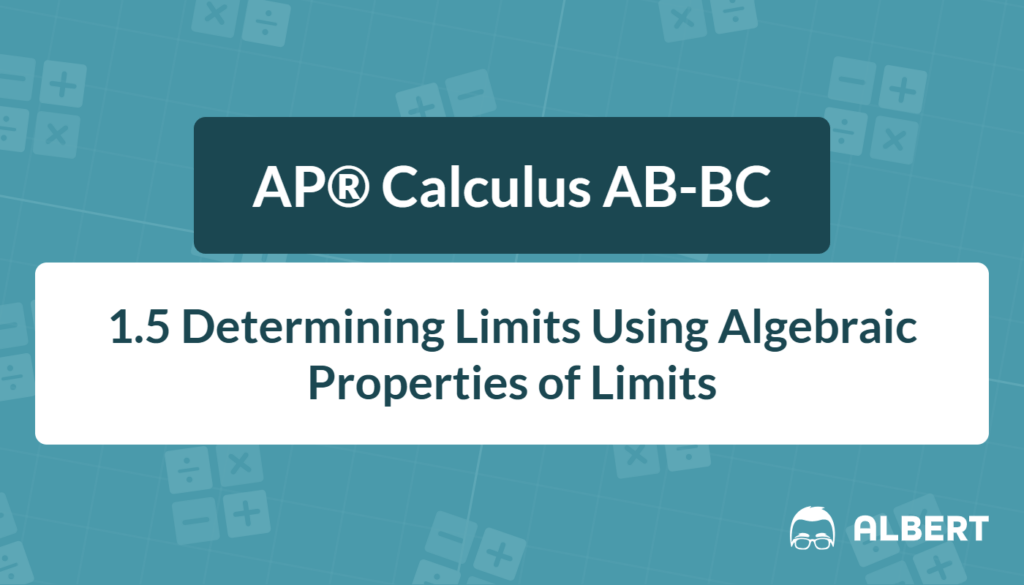A limit tells where a function is heading as the input gets very close to a chosen value. Mastering the laws of limits calculus is vital because almost every AP® Calculus question on derivatives, continuity, or integrals begins with a limit. This review focuses on three goals:
- One-sided limits
- The AP® Calculus AB-BC section called “1.5 algebraic properties of limits”
- Limits of composite functions
Each rule appears with clear steps, friendly explanations, and worked examples so that new learners feel confident.
What We Review
One-Sided Limits: Analytical & Graphical Approaches
Key idea
- Left-hand limit: \lim_{x\to c^-} f(x) means “approach c from values less than c.”
- Right-hand limit: \lim_{x\to c^+} f(x) means “approach c from values greater than c.”
A two-sided limit exists only when both one-sided limits match.
Finding one-sided limits analytically
- Direct substitution
- Algebraic simplification
- Factoring or rationalizing radicals
- Cancel any common factor before substituting again
Finding one-sided limits from a graph
Look at the y-value the curve approaches from one side of x = c. Ignore any open circle exactly at c; focus on the height the curve is trending toward.
Step-by-Step Example (Analytic)
Evaluate \displaystyle\lim_{x\to 2^-}\frac{x^2-4}{x-2}.
- Factor the numerator: x^2-4=(x-2)(x+2).
- Cancel the common factor (allowed because x is near 2, not equal to 2): \frac{x+2}{1}.
- Now substitute x=2: 2+2=4.
Therefore, the left-hand limit equals 4.
Step-by-Step Example (Graphical)
Imagine a piecewise graph with a solid dot at (0, 2) on the left branch and a solid dot at (0, –1) on the right branch. From x < 0, the graph climbs toward y = 2. From x > 0, it settles at y = –1.
- \lim_{x\to 0^-} f(x)=2
- \lim_{x\to 0^+} f(x)=-1
Because the one-sided limits differ, the two-sided limit does not exist. The picture shows a jump discontinuity.
AP® Calculus AB-BC 1.5 Algebraic Properties of Limits
The full list of algebraic limit laws is below.
Limit Laws quick rundown
For constants k and n, functions f and g, and value c:
- Sum/Difference: \lim_{x\to c}[f(x)\pm g(x)]=L\pm M if L=\lim_{x\to c}f(x) and M=\lim_{x\to c}g(x).
- Constant Multiple: \lim_{x\to c}k f(x)=kL.
- Product: \lim_{x\to c}f(x)g(x)=LM.
- Quotient: \lim_{x\to c}\frac{f(x)}{g(x)}=\frac{L}{M} if M\neq0.
- Power: \lim_{x\to c}[f(x)]^{n}=L^{n}.
- Root: \lim_{x\to c}\sqrt[n]{f(x)}=\sqrt[n]{L} when the root is defined.
Step-by-Step Example (Rational Function)
Evaluate \displaystyle\lim_{x\to 3}\frac{2x^3-4x}{x^2+5x-6}.
- Factor both parts.
- Numerator: 2x(x^2-2) = 2x(x-\sqrt2)(x+\sqrt2)
- Denominator: x^2+5x-6=(x+6)(x-1).
- Direct substitution now works, since no factor cancels at x=3.
- Plug in x=3:
- Numerator = 2(3)^3-4(3)=54-12=42.
- Denominator = (3)^2+5(3)-6=9+15-6=18.
- Divide: \frac{42}{18}=\frac{7}{3}.
Therefore, by the 1.5 algebraic properties of limits, the limit equals \tfrac73.
Limits of Composite Functions
Theorem
If \displaystyle\lim_{x\to c} g(x) = L and f is continuous at L, then
\displaystyle\lim_{x\to c} f\bigl(g(x)\bigr)=f(L).Continuity check
This rule fails when f is not continuous at L. Always confirm the inner limit exists and the outer function behaves well at that nearby value.
Step-by-Step Example (Trigonometric Composite)
Evaluate \displaystyle\lim_{x\to 0}\frac{\sin(3x^2)}{x}.
- Rewrite numerator using composite idea: let u=3x^2.
- Then \sin(3x^2) = \sin u and when x\to0, u\to0.
- Split fraction: \frac{\sin(3x^2)}{x}=\frac{\sin u}{u}\cdot\frac{u}{x}= \left(\frac{\sin u}{u}\right)\left(\frac{3x^2}{x}\right).
- Use the standard limit \displaystyle\lim_{u\to0}\frac{\sin u}{u}=1.
- Simplify: \frac{3x^2}{x}=3x.
- Finally, \displaystyle\lim_{x\to0}1\cdot 3x = 0.
Therefore, the limit equals 0, illustrating the limits of composite functions rule.
Putting It All Together: Mixed Strategy Problem
Find \displaystyle\lim_{x\to1^-}\frac{\sqrt{4x}-2}{x-1}.
- This is one-sided (approach from below 1).
- Direct substitution gives 0/0, an indeterminate form. Therefore, algebraic work is needed.
- Rationalize the numerator:
- \frac{\sqrt{4x}-2}{x-1}\cdot\frac{\sqrt{4x}+2}{\sqrt{4x}+2}= \frac{4x-4}{(x-1)(\sqrt{4x}+2)}.
- Factor 4(x-1) in the numerator and cancel x-1 (allowed since x is near 1, not equal to 1):
- \frac{4}{\sqrt{4x}+2}.
- Now substitute x=1: denominator becomes \sqrt{4}+2=2+2=4.
- The limit equals \frac{4}{4}=1.
This single problem required a one-sided view, rationalization (an algebraic property), and recognition of the square-root composite.
Common Pitfalls & Quick Tips
- Never cancel a factor containing the limit point before confirming it is non-zero.
- Check domains; a root may demand x ≥ 0.
- Remember continuity for composite limits.
- Mnemonic: Smart Cats Prefer Quality Premium Roots — Sum, Constant, Product, Quotient, Power, Root.
Quick Reference Chart
| Key Term | Concise Definition |
| Limit | The value a function approaches as x nears a point |
| One-sided limit | Limit taken from only the left or right side |
| Continuity | Function with no breaks, jumps, or holes at a point |
| Removable discontinuity | A “hole” that could be filled to make the graph continuous |
| Jump discontinuity | A sudden change in function value; one-sided limits differ |
| Composite function | Function inside another, written as f(g(x)) |
| Indeterminate form | Expression like 0/0 needing further work |
Conclusion
The laws of limits calculus unlock success on every AP® Calculus exam. Today’s review covered one-sided limits, the 1.5 algebraic properties of limits, and limits of composite functions. With practice on these rules, evaluating tricky limits becomes routine. Continue exploring related articles on derivatives and continuity to deepen understanding and earn higher scores.
Sharpen Your Skills for AP® Calculus AB-BC
Are you preparing for the AP® Calculus exam? We’ve got you covered! Try our review articles designed to help you confidently tackle real-world math problems. You’ll find everything you need to succeed, from quick tips to detailed strategies. Start exploring now!
Need help preparing for your AP® Calculus AB-BC exam?
Albert has hundreds of AP® Calculus AB-BC practice questions, free responses, and an AP® Calculus AB-BC practice test to try out.








